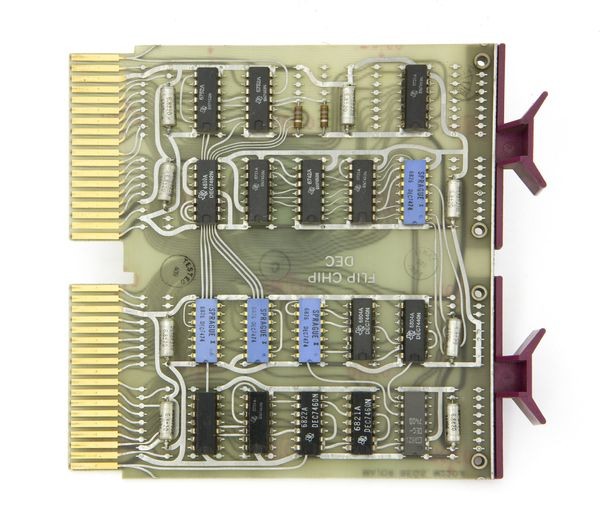DEC’s Blockbuster: The PDP-8
PDP-8
Over a 25 year span, DEC manufactured more than a dozen variations of the PDP-8 and sold over 10,000 machines.
DEC’s Blockbuster: The PDP-8
The Canadian Chalk River Nuclear Lab approached Digital Equipment Corporation in 1964. It needed a special device to monitor a reactor.
Instead of designing a custom, hard-wired controller as expected, young DEC engineers C. Gordon Bell and Edson de Castro did something unusual: they developed a small, general purpose computer and programmed it to do the job.
A later version of that machine became the PDP-8, one of the most successful computers of the next decade.
DEC PDP-8 computer in the rear of a VW bug
Karen Ericksen, a DEC salesperson, with a "classic" PDP-8 in the back seat of a Volkswagen Beetle convertible.
View Artifact DetailFirst PDP-8 brochure
Because DEC expected its customers to have engineering backgrounds, this brochure is full of technical details about how the PDP-8 works.
View Artifact DetailGordon Bell
Gordon Bell joined Digital Equipment Corporation in 1960 and spent 23 years (1960-1983) there as Vice President of Research and Development. Bell worked closely with Ed de Castro on the PDP-5, a forerunner to DEC’s successful PDP-8.
View Artifact DetailEdson de Castro
Edson de Castro worked closely with Gordon Bell on the PDP-5. De Castro then went on to design the initial version of the PDP-8. Afterward, de Castro was frustrated by DEC’s refusal to approve a family of 16-bit computers he wanted to design. So he and other DEC engineers launched Data General in 1968 and created their own 16-bit design.
View Artifact DetailWhat Was it Used For?
Engineers used the inexpensive PDP-8 in many varied applications, such as the control of the news display in New York’s Times Square, inexpensive time sharing at Carnegie Mellon University, signal analysis in physics labs, and lighting control in New York’s Shubert Theater for the musical “A Chorus Line”.
PDP-8 at Fenway Park, Boston
A PDP-8 controlled the graphic baseball scoreboard at the Red Sox’ ballpark.
View Artifact DetailPDP-8 at Massachusetts General Hospital
This PDP-8 monitored instrumentation in an operating room.
View Artifact DetailThe PDP-8 Family
The PDP-8/e appeared in 1970, the sixth generation of 12-bit computers from DEC able to run the same software.
The price for this newest member of the PDP family had dropped to $6,500, which made it inexpensive enough to serve as an embedded controller for other equipment.
PDP-8/e in office setting
The PDP-8/e was considered a general purpose minicomputer, because its configuration allowed many types of peripheral devices to be connected to it. It is shown here configured for data processing, with conventional teletypewriters (front foreground), and a line printer (back left).
View Artifact DetailPDP-8/e on surgery floor
A DEC PDP-8/e monitors and controls equipment used in a surgical operating room suite.
View Artifact DetailPDP-8/e brain surgery station
This brain surgery station served as a controller for a device that mapped the brain’s response to stimuli. Previously, brain surgeons had to keep patients awake during surgery. By wiring patients to a computer, doctors could stimulate nerves and analyze brain responses while patients slept.
View Artifact DetailSmaller Packaging: The Flip Chip Card
The PDP-8's electronic components were mounted on small inexpensive "Flip Chip" modules about the size of playing cards, plugged into connectors on a panel. The wire interconnections on the back of the panel were automatically made by a machine that wrapped wires around metal pins sticking out of the connectors, which significantly reduced cost.
The Flip Chip cards, smaller than the cards in the predecessor PDP-5, were originally designed for unpackaged diodes and transistors densely mounted on ceramic substrates. That idea failed. But with clever layout, DEC engineers were able to squeeze conventionally packaged components into the new smaller size.
For the next compatible machine, the PDP-8I, the Flip Chip cards held integrated circuits instead, which packed much more logic into the same space.
Gardner Denver wire wrap machine
An automated machine took over the tedious and error-prone job of wiring all the connector pins on the backplane. This saved both time and money.
View Artifact DetailPDP-8 transistor/diode logic module (triple flip flop)
This register slice contains 3 bits of storage and 1 bit of an adder. It performs the same functions as the PDP-5 module, but is on a smaller printed circuit card.
View Artifact DetailPDP-5 transistor/diode logic module (triple flip flop)
This register slice from the predecessor of the PDP-8 contains 3 bits of storage and 1 bit of an adder. The transistors have the black top hats, and the diodes are the small white cylinders.
View Artifact DetailPDP-8/I IC logic module
This register slice contains 8 bits of storage and 2 bits of an adder. It was used in the PDP-8/I, successor to the PDP-8, which had integrated circuit logic circuits.
View Artifact Detail



















